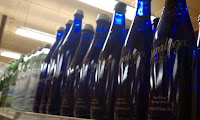by Maria Noël Groves, Clinical Herbalist & Co-op Wellness Educator
Imagine doing your shopping, bringing groceries home, and eating them without throwing a single thing in the trash can. While it's difficult to be 100% perfect, here are some easy ways to reduce your grocery waste:
 |
| Brendan can answer your bulk questions! |
 Refill Your Own Containers in Bulk. Buying items from the bulk aisle automatically means less waste. However, you can improve your carbon footprint by bringing your own containers in to fill rather than using a new plastic bag or container each time. Wide-mouth mason jars work particularly well and are also great for storing items in your pantry, but any container will do. Try masking tape to label the jar - it stays on well and then comes off easily when you want it to. You'll need to at least put the PLU number from the bin and get the "tare" (weight of the empty container) at the registers so that the cashier can properly ring your item. A wide range of products are available: grains, snacks, beans, coffee, spices, olive oil, maple syrup, honey, granola, nuts, kombucha, olives...
Refill Your Own Containers in Bulk. Buying items from the bulk aisle automatically means less waste. However, you can improve your carbon footprint by bringing your own containers in to fill rather than using a new plastic bag or container each time. Wide-mouth mason jars work particularly well and are also great for storing items in your pantry, but any container will do. Try masking tape to label the jar - it stays on well and then comes off easily when you want it to. You'll need to at least put the PLU number from the bin and get the "tare" (weight of the empty container) at the registers so that the cashier can properly ring your item. A wide range of products are available: grains, snacks, beans, coffee, spices, olive oil, maple syrup, honey, granola, nuts, kombucha, olives...
Buy Local Dairy with a Bottle Deposit. Some of our dairy farmers provide milk, keifer, and cream in glass containers. You pay a bottle deposit up front, and when you bring the clean container back, the cashier will refund you. Look for items from Bartlett Farm in Concord and Brookford Farm in Canterbury.
Re-use Produce Bags. Whether you bring lightweight cloth, Ziplock, or re-use plastic bags, you can easily reduce your waste. Or buy items lose and transfer them into storage containers when you get home. Be sure to wash them regularly.
Bring Your Own Grocery Bags. Bring your own canvas (or any type of) bag to bring your groceries home. This saves on plastic waste and also earns 5 cents per bag for the Community Partner of the month.
Shop Fresh. Eating from the perimeter of the store, particularly our produce and bulk aisles, will automatically generate less waste... and is generally healthier for you, too!
Compost. Toss corn husks, peach pits, apple cores, kale stems, teabags, outdated leftovers, egg shells, coffee grounds, stale bread and the like in the compost bin. Even a lazy compost pile will eventually turn into great soil, and urban composters can try composting with worms. (Don't compost meat, bones, excess grease, eggs, or dairy products, though.)
BONUS: By eating more fresh foods and storing them in glass or cloth, you'll significantly reduce your blood levels of harmful BPA and other problematic plastic compounds within just a few days! Click here to learn more about the study.
What's YOUR favorite way to reduce waste when you shop? Let us know in the "Comments" section below!





